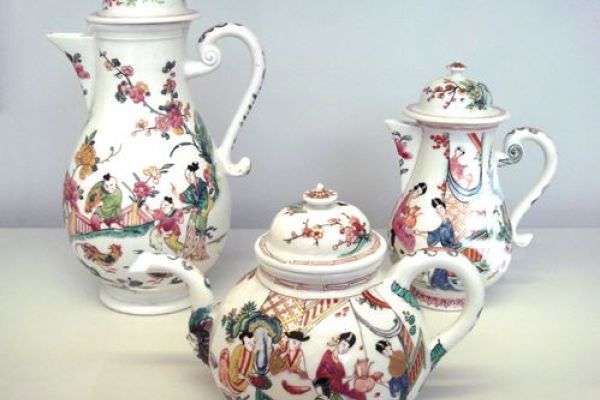
- This event has passed.

Hard porcelain teapot set, Meissen 1720. Musée des Arts Décoratifs, Paris.
Enjoy a morning with the CSG as we follow Edmund de Waal’s exploration of the history of porcelain in his latest book The White Road. Guest speakers will discuss the development of porcelain in China, the craze for all things oriental in Europe and the ‘discovery’ there of how to make porcelain. Members are encouraged to bring in porcelain pieces from their own collection to share with others.
Iain Clark, independent researcher interested in late imperial and modern Chinese ceramics; inaugural member of the Oriental Ceramic Society of Jingdezhen established in 2017.
De Waal’s White Road: the beginnings in China
Iain will help us unravel the question of what exactly is porcelain. He will talk about the porcelain city of Jingdezhen, referring to the vivid account provided by Jesuit Father d’Entrecolles’ letters in the early 18th century. Iain will illustrate his talk through a comparison between an early Ming white porcelain dish and Chinese white soft paste porcelain.
Margaret White, has a special interest in ceramics and in the arts of Southeast Asia. She is former President and Advisor of the Friends of the Museums, Singapore.
Chinoiserie: the craze for all things ‘Chinese’
This decorative Western style drew inspiration primarily from the arts of China, Japan and India, reaching its apogee in Europe around the mid-18th century and affecting every area of design and décor. Margaret’s presentation will discuss the obsession with Chinese and Japanese porcelain, its influence and impact, not only in the Royal Courts of Europe but on society in general.
Elizabeth Ramsden, ceramic collector with a deep interest in 18th century European porcelain and the influence on it of China and Japan. For almost 40 years Elizabeth has been very involved with the Ceramic Collectors Society.
True Porcelain in 18th Century Europe – from Meissen in Germany to Plymouth in England
Elizabeth will take up the porcelain story in her account of how the secret of making true porcelain, ‘white gold’, was desperately pursued in various European ceramic centres. The race was won by Saxony, where the Royal Saxon Porcelain Manufactory was established in Meissen in 1710 but this did not deter English and French attempts that followed.
Steve Harrison, a ceramic practitioner for 47 years has studied the art of porcelain making in China, Japan, Korea, UK and Australia. His book ‘5 Stones’ details his research into the origins of porcelain. He trained at East Sydney Technical College under Peter Rushforth, subsequently apprenticed to Japanese potter Shiga Shigeo.
Making porcelain: a practitioner’s viewpoint
Much of today’s porcelain manufacture is divorced from its source, made from a cocktail of imported, trans-national ingredients However, there is some porcelain production at a few sites around the world where ancient local materials are still worked. Steve will talk about his travels to these sites to collect samples for his research and to make work for his exhibitions.
TAASA members and guests are invited to bring relevant pieces they would like to share and discuss.
RSVP: Margaret White at:Margaret.artmoves@gmail.com.
Payment:
1) Via this website – see bookings button above right
2) By EFT to TAASA’s account:
BSB: 012-003; Account no.: 2185 28414 (please indicate name plus ‘CSG’)
3) Or cash at door